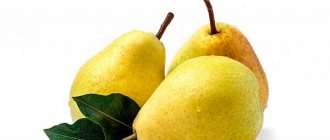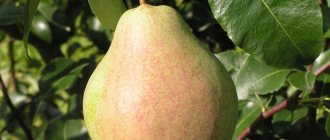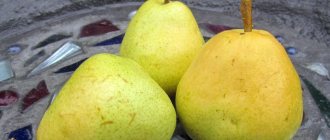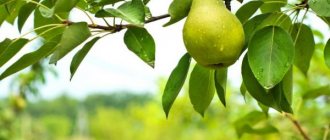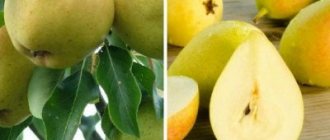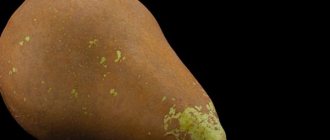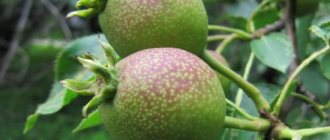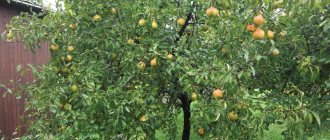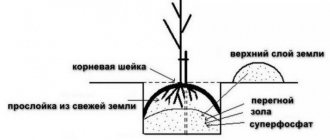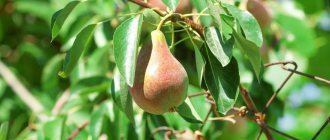What type of pear is it?
Pear "Noyabrskaya" is an autumn early-fruiting variety that has been grown in Russia since the second half of the 20th century.
The variety is quite in demand among gardeners.
The fruits of “Noyabrskaya” can be stored for a very long time, they are juicy, tasty and good in compotes, jams, jams, preserves, confitures and dried.
Autumn varieties also include: Osennyaya Yakovleva, Samara Beauty, Tatyana, Skazochnaya and Larinskaya.
History of selection and region of breeding
“Noyabrskaya” was bred by the Far Eastern Research Institute of Agriculture. The author of the variety is breeder A.V. Bolonyaev.
The scientist crossed the wild frost-resistant Ussuri pear with the variety from Belgium “ Dekanka Zimnyaya ”, as a result of which he received a very hardy pear called “Noyabrskaya”.
Gardeners often confuse two different varieties with each other: “Noyabrskaya” pear and “Noyabrskaya winter” pear - in this article you will see a description of the “Noyabrskaya” pear, an autumn variety.
In 1950 it was first described, in 1958 it was transferred for testing to a state nursery, and in 1974 it was recommended for cultivation in the Far East.
Most often, “Noyabrskaya” can be found in the south of Khabarovsk and along the entire coast of the Primorsky Territory. Due to its high winter hardiness , the Noyabrskaya pear is successfully grown in the middle latitudes of Russia, as well as in the southern regions of Western Siberia.
The following pear varieties thrive in this region: Hera, Cathedral, Krasnobokaya, Elena and Vernaya.
Pear "Noyabrskaya": description of the variety and photo
The pear variety “Noyabrskaya” is a tall, vigorous tree with a pyramidal crown ; the description of the tree differs greatly from the fruits, since they are small, as you can see in the photo below.
The skeletal branches of the pear are prone to dense branching and grow upward.
The fruits are formed on two- and three-year-old branches, which are shortened twigs and simple ringlets. The bark of the branches is colored greenish-burgundy.
Pear leaves have an elongated oval shape with a pointed tip and slightly jagged edges. The upper part of the dense leaf blade is dark green, and the lower part is light green.
The “Noyabrskaya” variety cannot boast of large fruits . Their weight ranges from 64 g to 74 g. The shape of the pear is ovoid with pronounced ribbing and most often slightly unequal . The fruits of “Noyabrskaya” are characterized by a blunt, as if cut, lower base.
The top with irregularities and a small depression is also slightly beveled. The main color of the fruit is light green with a yellowish tint. On barrels facing the sun, a light burgundy blush usually appears.
The white flesh of the November pear is juicy and slightly oily. Its taste is sweet and sour and very pleasant, with a wonderful fragrant aroma. In terms of sweetness, “Noyabrskaya” is not inferior to many popular varieties - the amount of sugar in it is at least 10.8%.
Take a closer look at the “Noyabrskaya” pear in the photo below:
Watch the video in which you will see what the fruits of the November pear look like.
Harvesting
The Noyabrskaya pear variety begins to bear fruit in the second year. The beginning of ripening is the second half of September. During the monsoon rains, the fruits do not fall. After aging for a month from the moment of ripening, the pears acquire the best taste characteristics and are well preserved until the end of December.
Noyabrskaya has unsightly pears with high taste qualities
Further storage successfully occurs in dried or frozen form. After thawing, pears practically do not lose their taste. Also, November pear is perfect for home canning: compotes, preserves or marmalade.
Fruits of the November pear - video
Characteristics
High and stable yield is one of the many advantages of the variety.
When tested in state nurseries, 54.8 c/ha were collected from trees of the Noyabrskaya variety at the age of 9 years, 90.6 c/ha at the age of 10 years, and the highest yield was 212 c/ha.
Excellent productivity is also demonstrated by Krasulya, Lada, Lyubimitsa Yakovleva, Detskaya and Dekabrinka.
The variety is fast-growing and begins to produce crops in the 3rd or 4th year of life .
5 years after planting, the pear bears fruit in full force.
A faster start to fruiting can be achieved by using the Quince VA-29 rootstock.
The variety is self-sterile. The best pollinators of the “Noyabrskaya” pear are autumn varieties, along with the flowering pear Oktyabrskaya or Yablokovidnaya, etc.
Pears of the “Noyabrskaya” variety ripen in late September. However, they acquire their wonderful taste only a month after harvest.
It is worth saying that the fruits stick very tightly to the tree and do not fall off even in strong winds. In addition, they have good keeping quality and are perfectly preserved until the New Year , and sometimes a little longer.
Although “Noyabrskaya” is considered a cold-resistant variety, in climate zones with harsh winters it can freeze, so it needs good insulation .
In the Amur region, this variety is mainly grown in stale form , which greatly facilitates its protection from too low winter temperatures.
The following pear varieties have excellent frost resistance: Rogneda, Rossoshanskaya Krasivaya, Feeriya, Duchess and Tonkovetka.
Advantages and disadvantages
The Noyabrskaya pear has many advantages that need to be outlined:
- regular fruiting, allowing you to get a harvest from the trees every year;
- resistance to burns, which allows the pear to more easily endure the early spring period;
- early fruiting - the first harvest can be harvested already in the second or third year after planting the seedling;
- increased resistance to fungal diseases, in particular scab;
- the fruits do not fall off after ripening even in extreme conditions (for example, during monsoon rains).
- the harvest is well stored - there are cases when the fruits retained their best qualities until April.
The pleasant sweet and sour taste, thanks to which Noyabrskaya is considered a good table variety, only adds to its attractiveness. In terms of its taste, the pear is similar to the November Beauty variety. Productivity is from 40 to 60 kg per tree, which is a good indicator (the same figure is listed for another autumn variety - Volshebnitsa).
The yield of Noyabrskaya is not bad - 50–60 kg per tree
Good winter hardiness (especially in the root system), which helps to survive in the difficult conditions of the Far East, is Noyabrskaya’s trump card. This quality is especially stable when grown at higher elevations. In warmer latitudes, pear trees feel even more comfortable and survive the winter easier. This is a significant advantage compared to other autumn varieties like Moskvichka or Rassvet, which tolerate cold less well with the same harvest volume.
The disadvantage of the variety can be considered the appearance and size of the fruit - small and unsightly pears are not suitable for sale. But they are perfectly used for personal needs by amateur gardeners (for fresh consumption, in compotes, jams, etc.).
Noyabrskaya fruits do not have a marketable appearance, but they more than compensate for this with their quantity and excellent taste
Video: Fruits of the November pear
Planting and care
For planting, it is advisable to choose pear seedlings two years old .
When purchasing, special attention should be paid to the roots - they must be well developed.
The time for planting can be either spring or autumn.
Pears prefer to grow in dry and open areas with loamy or sandy loam soil.
On sandy soil, their productivity decreases, and on overly moist soils, pear trees die.
Groundwater must be located at a depth of at least 2.5 meters. The pear tree does not tolerate shade, so it is advisable to plant it at a distance of at least 4 meters from tall buildings.
The planting hole must be prepared in advance: for autumn planting - 14-15 days in advance, for spring planting - in the fall. The depth of the hole for a vigorous “Noyabrskaya” pear should be at least 1 or even 1.2 m, and the diameter should be at least 80 cm. The planting pattern for vigorous trees is 4 by 5 m.
When preparing the pit, the top layer of earth with a thickness of 30 to 40 cm is folded separately. It is used to prepare a fertile mixture.
In addition to the top turf layer, three buckets of manure or plant humus , about two buckets of sand , no more than a glass of superphosphate , and about three tablespoons of potassium sulfate .
If the soil on the site is acidic, add one and a half kilograms of lime . The nutrient mixture is thoroughly mixed, the hole is filled two-thirds with it and left until planting.
Before planting, a peg is driven into the hole (30 cm from the center). Then a mound is formed at the bottom, a seedling is placed on it and all the roots are carefully straightened to the sides.
Next, the hole with the installed tree is covered with earth, not forgetting that the root collar should be located 4 or 5 cm above the soil surface. The earth is well compacted and spilled with 3 or 4 buckets of water.
To do this, an earthen groove is formed along the contour of the pit for irrigation. Next, the area around the seedling is mulched with peat, sawdust or humus , and the tree itself is tied to a peg using the figure-of-eight method.
Young, recently planted pears are watered on average 4 times a month . A bucket of warm water is enough for each tree. Mature pear trees do not need frequent watering, since their strong root system grows deep and is able to obtain water for itself.
The first watering is carried out in the spring before the buds swell, the second - in late spring or early summer, after the pear blooms. With the beginning of leaf fall, the third watering . One tree aged 3 to 4 years requires at least 6 buckets of water.
The water norm for an older pear is 3 buckets per 1 square meter of area under the crown. Sprinkling is considered the best way to water a pear.
Important! The pear tree trunk should be kept clean and protected from weeds throughout the season. Also, the ground around the pear needs to be regularly loosened and mulched.
You can start feeding a pear in the 2nd or 3rd year of its life.
Every two or three years, organic matter should be added in the form of mullein or slurry.
In the spring, pear trees are fed with nitrogen fertilizers , and in the fall - with phosphorus-potassium fertilizers.
During the flowering period, it is recommended to spray the plants with a solution of sulfate (2%), urea (2%) or superphosphate (3%). The pear also benefits from foliar fertilizing with urea after harvesting.
Formative pruning of the “Noyabrskaya” pear is carried out immediately after planting. All branches are shortened by a third. Further, throughout its life, the tree needs sanitary and rejuvenating pruning.
Every spring the crown is thinned out, dry, diseased and damaged branches are removed. Two-year-old shoots are also shortened and three-year-old fruit-bearing branches are pruned. It is important to always maintain the leading position of the central conductor.
If the branch is completely removed, it is undesirable to leave stumps, as they impede wound healing. When pruning pear trees, no more than 25% of all branches should be removed so as not to subject the tree to severe stress.
In regions with cold winters, the “Noyabrskaya” pear can freeze slightly and therefore needs protection.
The tree trunk circle is mulched for the winter with a thick layer of earth or horse humus.
The log is wrapped in insulating material and then covered with pine spruce branches or mesh to protect against rodents.
Features of cultivation
It is best to choose a planting site on the sunny side of the site. A slight elevation with protection from the wind is recommended. It is advisable to plant in the spring, so that during the season the plant adapts to new conditions and strengthens its immunity. The planting process is typical for the crop.
Basic steps:
- In the fall, prepare a planting hole measuring 70x70 cm. Fill it with a nutritious substrate of fertile soil, humus and peat in equal proportions. Additionally, it is recommended to add 200 g of wood ash, 10 g each of superphosphate, potassium sulfate and ammonium nitrate.
- Place the peg exactly in the center of the hole, cover the surface with film or other material to create a useful microclimate.
- It is better to plant a pear in the morning or evening. The seedling is placed in the center of the hole and the roots are carefully straightened.
- Cover the tree with fertile soil, leaving 2-3 cm to the level of the root collar.
- Tie the seedling to a peg, compact the soil in the tree trunk area, and mulch with peat or sawdust.
Immediately after planting, the tree should be watered generously with warm water at the rate of 10 l/m2. It is advisable to carry out the first feeding no earlier than 10-14 days from the moment of planting. The tree is vigorous; when planting, an interval of 2-4 m between trees, about 3-5 m between rows, should be maintained.
The November pear is suitable for beginner gardeners; it is easy to care for, easy to plant, and infestation with diseases and pests is extremely rare. It is especially important to follow all necessary procedures in the first year of growth, when the plant is actively growing and developing.
Care requirements:
- This variety of pear prefers moderately moist soil; it is advisable to water it once every 2-3 weeks at the rate of 10-12 liters per plant. It is advisable to apply water by sprinkling so that the plant receives moisture through the leaves;
- in the first year of growth, it is necessary to regularly loosen the soil to increase aeration and remove weeds;
- Already from the first year you can start pruning. The procedure is exclusively sanitary in nature. In an annual plant, the central shoot is shortened by half, and then pruning by 10-15 cm is required. For adult plants, all dry, diseased and deformed shoots are cut off. In spring, it is advisable to shape the crown by cutting off excess skeletal branches;
- A fairly thick layer of mulch should be maintained throughout the season. The optimal thickness is 20-30 cm. Sawdust, dry peat or fallen leaves are suitable as materials;
- fertilizing is applied three times during the season - in spring, at the time of ovary formation and in autumn. You can use both organic matter (mullein solution in a ratio of 1:10) and complex mineral fertilizer. You only need to fertilize at the roots.
The variety has high frost resistance; even when grown in cold regions, shelter is not required. In the fall, before the onset of frost, it is enough just to add a layer of mulch and also trim off all weak shoots.
Possible diseases and their treatment
The Noyabrskaya pear variety has strong immunity to scab, powdery mildew and other diseases characteristic of the crop. When grown in humid and cool climates, there is a risk of pest infestation.
During the season, it is advisable to carry out preventive treatment with a chemical insecticide (Karbofos, Iskra, Agravertin or Kinmiks) three times. Spraying is carried out before the buds begin to swell, before flowering and after fruit set.
During the procedure, all vegetative parts are sprayed, and the area around the trunk circle, where insect larvae and eggs are often located, is also watered.
Among the huge variety of varieties the “Noyabrskaya” pear stands out because it produces high yields of tasty and aromatic fruits with excellent keeping quality , almost does not get sick, and is unpretentious and hardy in care.
In order for the “Noyabrskaya” pear to show itself in all its glory, you just need to provide it with proper care and reliable protection from pests; further in the article there is a description of agricultural technology, photos and videos of the fruits.
Diseases and pests
The “Noyabrskaya” variety is resistant to fungal diseases and even to such common pear diseases as bacterial blight and .
The following varieties are resistant to diseases: Chizhovskaya, Lel, Severyanka, Moskovskaya rannyaya and Chudesnitsa.
However, she is not immune to pests. The fight against voracious insects begins in early spring.
To prevent the appearance of pests, the trunks and skeletal branches of the pear are cleaned of old bark . Plant residues and carrion are removed from the site in the fall.
These agrotechnical measures help destroy wintering nests and egg-laying pests. To collect pear moth caterpillars, catching belts are installed on the lower parts of the trunk.
With a large number of pests, unfortunately, insecticides cannot be avoided. To destroy insects dangerous to pears, several treatments are carried out (3 to 5 times per season).
Trees are sprayed 1 or 2 times at the moment the buds swell , once before flowering and after flowering, a couple of weeks after flowering and in the fall . The number of treatments can be increased if the pear is protected from insects that produce two generations over the summer.
Karbofos, Calypso , Iskra, Tsitkor, Fury, Kinmiks, Aktara , "Decis", "Agravertin".
“Colloidal sulfur”, “Fito-verm”, “Demitan”, “Agravertin”, “Nearon” are used against gall mites
Such important qualities for pears as good keeping quality of the fruit and resistance to fungal diseases distinguish “Noyabrskaya” from other varieties.
By planting it on your plot, you can enjoy high yields of healthy fruits every year and enjoy them even on New Year’s holidays.
